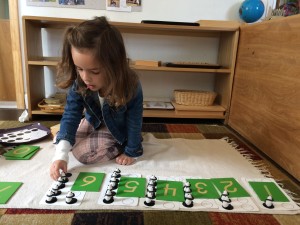 “Movement has great importance in mental development, provided that the action which occurs is connected with the mental activity going on.” –Maria Montessori, in The Absorbent Mind (1947)
“Movement has great importance in mental development, provided that the action which occurs is connected with the mental activity going on.” –Maria Montessori, in The Absorbent Mind (1947)
Children move. This is how they learn about the world around them. Beginning with the infant turning its head, rolling over and learning to crawl to the toddler who picks each item on a shelf, movement is how the young child connects the inputs from her five senses. Imagine, a 3-year-old sees a green plant and smells some sweetness, but not until approaching and touching–perhaps with the nose, perhaps picking a leaf–does s/he connect the smell of basil to the particular plant.

The Montessori classroom uses these tendencies to structure learning. Order begins to develop with placing stones in an orderly fashion, rolling up their workmat and cleaning tables, then moves forward with counting rods in a box, placing beads in an orderly triangle, handling the 10 red rods. It is easy to think that the materials on our shelves are simply entertaining to the child. Well, they are entertaining, but that’s not why we have them in our classroom.
 Through moving objects around the table and about the classroom, the child’s body is making sense of the orderly patterns that will surround them the rest of their life. Through these active tasks, the young child develops a sense or order and purpose. Its not stretch to imagine that a young child–even a 2 year old–can readily trace sandpaper letters with their finger, and then write letters in the sand or on a chalkboard, but that same young child is not yet ready for the stillness and concentration necessary to read. As the child continues to grow within the Montessori classroom, s/he will develop the concentration and skills necessary to move on. Thus primed, mind will bring forth the writing, counting, reading, adding and subtracting and so much more have been waiting.
Through moving objects around the table and about the classroom, the child’s body is making sense of the orderly patterns that will surround them the rest of their life. Through these active tasks, the young child develops a sense or order and purpose. Its not stretch to imagine that a young child–even a 2 year old–can readily trace sandpaper letters with their finger, and then write letters in the sand or on a chalkboard, but that same young child is not yet ready for the stillness and concentration necessary to read. As the child continues to grow within the Montessori classroom, s/he will develop the concentration and skills necessary to move on. Thus primed, mind will bring forth the writing, counting, reading, adding and subtracting and so much more have been waiting.
Indeed, by giving purpose to their movements and enabling them to learn, the Montessori classroom sets up children for future success.


1 thought on “Orderly movement in the Montessori Classroom”
Comments are closed.